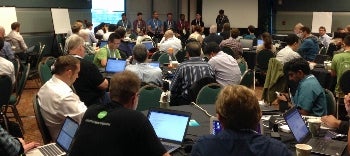New members commit to advance open source Network Functions Virtualization
SAN FRANCISCO, October 20, 2015 — The OPNFV Project, a carrier-grade, integrated, open source flexible platform intended to accelerate the introduction of new products and services using Network Functions Virtualization (NFV), today announced that Freescaleand KDDI R&D Labs have joined as Silver members while Morgan Richomme of Orange has been appointed to the Board of Directors as the first technical community representative. Launched just one year ago, the OPNFV project is supported by 19 Platinum and 36 Silver member companies committed to advancing the creation of a flexible, open source framework for NFV.
With over 100 developers from both commercial suppliers and service providers collaborating on the development of an open source, carrier-grade, integrated platform for NFV, the project has issued an update to its first release, Arno, and is hard at work on its second release due early next year.
“We are seeing vibrant collaboration coming from the OPNFV community across many sectors, which is key to accelerating the open source software development of NFV,” said Heather Kirksey, director, OPNFV. “Our newest Silver members, Freescale and KDDI R&D Labs, which bring additional semiconductor and telecoms expertise to the project, are a welcome addition. We’d also like to congratulate Morgan Richomme of Orange on his appointment to the Board of Directors. His strong network architecture experience is an asset and we are happy to have his guiding input.”
More on the newest OPNFV members, listed in alphabetical order:
Freescale Semiconductor enables secure, embedded processing solutions for the Internet of Tomorrow. Freescale’s solutions drive a more innovative and connected world, simplifying our lives and making us safer. While serving the world’s largest companies, Freescale is also committed to supporting science, technology, engineering and math (STEM) education, enabling the next generation of innovators.
“Offering industry-leading multicore processors based on ARM technology, Freescale is committed to creating a vibrant, open and competitive NFV ecosystem,” said Sam Fuller, director of strategy for Freescale’s Digital Networking group. “The OPNFV platform helps ensure carriers have access to the best silicon, software and system technologies for building next-generation networks, and Freescale is pleased to join the OPNFV project to contribute our processing and networking expertise in support of the OPNFV project’s goals.”
KDDI R&D Labs Inc., a subsidiary of KDDI Corp., conducts research and development on next-generation information and communication technologies in a wide range of fields, from mobile wireless technology to social media analytics. Specific to SDN and NFV, KDDI R&D Labs have successfully completed Proof-of-Concepts (POCs) of closed-loop automated operation by using management technologies tightly related to OPNFV projects.
“We strongly believe that open source software and community will help accelerate its R&D process, and we understand the importance of SDN/NFV platform and relevant open innovation efforts,” said Yasuyuki Nakajima, president, chief executive officer, KDDI R&D Labs. “We also hope that our experiences in future mobile networking as well as fixed networking contribute to OPNFV project activities.”
Elected by OPNFV technical committers to increase developer and technical share of voice on the Board of Directors, Morgan Richomme of Orange was named the first Committer member of the Board.
“I am thrilled to join the OPNFV Board of Directors, representing the developer community in the trenches,” said Morgan Richomme, NFV architect, Orange. “OPNFV is unique in that it combines both the Cloud IT and traditional telecoms industries, which are both necessary to solve NFV. It facilitates broad collaboration in building a flexible platform for NFV in an industry on the precipice of transformation.”
Results from OPNFV’s annual Silver member election re-appointed current members, including: Bob Monkman, segment marketing manager, ARM; Chris Donley, director, virtualization and network evolution, CableLabs; Cliff Young, founder and CEO, ClearPath Networks; and John Zannos, VP, worldwide alliances/ business development/ cloud platform Canonical.
OPNFV is preparing for the inaugural OPNFV Summit in Burlingame, Calif. November 9-12, 2015. The Summit will enable collaboration between service providers and networking industry and open source communities to advance the development and adoption of an open source NFV platform. More details on the OPNFV Summit, including agenda and registration, are available here: http://events.linuxfoundation.org/events/opnfv-summit
Anyone can participate in the OPNFV community regardless of affiliation or location. Technology contributions, concepts or ideas can be shared here. Join the discussions, listen to the debates and contribute to the advancement of open source NFV.
About Open Platform for NFV (OPNFV)
Open Platform for NFV is a carrier-grade, integrated, open source flexible platform intended to accelerate the introduction of new products and services using NFV. It brings together service providers, vendors and users to collaborate in an open forum on advancing the state-of-the-art in NFV. For more information, please visit: http://www.opnfv.org.
OPNFV is a Collaborative Project at The Linux Foundation. Linux Foundation Collaborative Projects are independently funded software projects that harness the power of collaborative development to fuel innovation across industries and ecosystems.www.linuxfoundation.org
# # #
Additional Resources
Getting Started with OPNFV
Joining the OPNFV Community
OPNFV Blog
OPNFV Events
Media Inquiries
Jill Lovato
OPNFV Project
pr@opnfv.org


 Margaret Chiosi, AT&T
Margaret Chiosi, AT&T Dr. Prodip Sen, HPE
Dr. Prodip Sen, HPE



 Trevor Cooper has over 20 years of experience developing and deploying new technology solutions
Trevor Cooper has over 20 years of experience developing and deploying new technology solutions